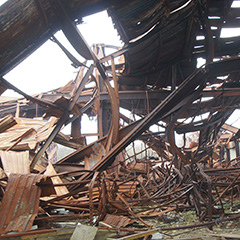Subsidence and Heave
It is not unusual in the SE of England that tree roots cause shrinkage of the London Clay subsoil. Other types of clay throughout the UK can also be similarly affected.
Foundation depths in London clay would normally be at a minimum depth of around a metre but where vegetation exists, or will be planted or has been removed greater foundation depths are likely to be required.
If your house is suspected of suffering from subsidence movement then notify your insurance company.
Recovery actions may follow perhaps against a neighbour if the tree that is proven to have been the main cause of subsidence to your property is unfortunately their tree. Routine investigations apart from testing the soil for desiccation and the analysis of tree roots may also involve monitoring the property by precise levelling and crack width movement.
Heave (volumetric expansion of clay when it rehydrates) forces arising from severed roots or from tree removal can be of sufficient magnitude to physically raise a two storied house. The range of movement will vary depending on the depth of desiccation but up to 65mm and beyond is not uncommon. Question anyone that states heave movement will cease in a short space of time particularly when the full coverage of trees that at one time existed on site prior to development is not known. It may do, but I am aware that in some cases heave movement may be delayed for several years before movement can be detected.
It is also possible that defects in drainage may contribute to foundation failure.

Fire Claims
The analysis of a fire damaged building to understand what if anything of the structure can be saved is probably the most taxing of surveys I carry out.
Foundations can suffer from collapse loadings during a fire that will bring into question their reuse.
Most damage of course is readily visible but by a careful inspection and some testing all materials that need to be removed should be identifiable.
Because fire damage can be both severe and extensive reinstatement costs of equipment lost in a fire can often exceed the pure cost of reinstating the building fabric services and finishes. The result is often the need to consider recovery actions against professionals who may have designed the building in the first instance. Rapid fire spread is often fuelled by the fire load but will be accelerated further by a lack of fire protection to building elements that should have been designed to resist or prevent the fire from occurring.
Flood Claims
Poor building maintenance often causes flooding but inadequate design can also be a factor.
How many householders can honestly say they regularly have their drains rodded or jetted despite the fact that most insurance policies require the insured to maintain their property. The treatment of a flood damaged building is a slow process. Most of the structure will sustain a flood without damage but equally the finishes applied will not. Some flood claims are readily identified as fraudulent. Recovery actions will be pursued particularly if the building was designed with a fault or if poor workmanship or defective materials have been installed in the building that contributed to the flooding.

Storm Damage Claims
It is surprising that many building defects become apparent in winds that are well below storm classification.
It is equally often the case that fabric will drop off a building that was inadequately designed for wind in the first place. Collateral damage from storms needs to be carefully assessed.
Meteorological records are of great assistance in determining whether storms were present but the nearest weather station may be miles away, The examination of records i.e. wind speeds etc therefore needs careful interpretation especially when material is bodily removed from a building during an alleged storm as it will give a good guide to whether the wind gusts were of storm magnitude.
Fraudulent Claims
Unless there has been a blatant fraudulent claim most insured's claims are speedily brought to a conclusion.
The excessive value claimed for losses can be deliberate or may simply be mistaken. Serial claims oriented people are however known to the insurance world who often share information with other companies.

Personal Injury
This subject is full of surprises as to the accidents people have doing the most basic of tasks. Falls from height are a regular occurrence that can have agonising repercussions even when falling from as little as the second tread of a pair of step-ladders.
Fatal and serious accidents from alleged defective scaffolding appear on my desk each year.
Trips and slips are also a perennial with accidents occurring in shopping malls, places of work, health clubs and swimming pools. Inappropriate footwear may be the cause in some instances. Supermarkets are also an arena where slippage on liquids or other produce, has a high occurrence.



